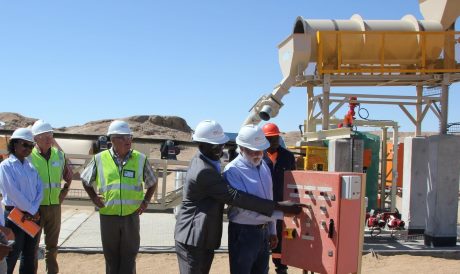Namibia commissions demonstration uranium plant
26 March 2015
Bannerman Resources has officially opened a heap leach demonstration plant at the Etango uranium project in Namibia.
 |
| The demonstration plant is officially opened by Patrick Elungu, Namibian Ministry of Mines and Energy chief inspector, and Wotan Swiegers, director of the Namibian Uranium Institute (Image: Bannerman Resources) |
Construction work began on the plant in October 2014 and it is expected to deliver its first test results by the end of June. The plant will demonstrate the design and projected performance in the definitive feasibility study for the project, as well as building knowledge and enabling the company to pursue value engineering ahead of full production.
Etango is 30 km southwest of Rio Tinto's operating Rössing uranium mine and has similar alaskite ore to that found at Rössing, with measured and indicated uranium resources of 57,330 tU and inferred resources of 24,600 tU. With much of the resource less than 200 m deep, it is amenable to conventional open pit mining and sulphuric acid heap leaching in what Bannerman describes as a low technical and environmental risk project.
From the definitive feasibility study, Bannerman envisages production of around 2700 -3500 tU per year over the first five years of production and 2300-3100 tU per year thereafter, over a minimum mine life of 16 years. This would place Etango within the world's the top ten uranium mines in terms of production.
The heap leach demonstration plant will process ore using four 5 metre-high cribs to process individual 40 tonne ore samples as well as simulating the planned heap leach pad operation by circulating the leached solution between the cribs.
A 3000 tonne sample of ore has been taken from the Onkelo region of the deposit. Crushed and blended to represent the assumed orefeed in the final operation, it will enable up to three years of testing to be carried out.
Bannerman holds 80% of the Etango project and has long been seeking a development partner. A 2011 takeover offer from China's Sichuan Hanlong group did not proceed, and a 2012 agreement that would have seen Namibian state-owned Epangelo Mining Ltd buy a 5% stake in the project was also called off. As well as proving the technology for the mine, the demonstration plant will also demonstrate the viability of the operation to potential investors and financiers.
Bannerman chief executive officer Len Jubber remarked that the commissioning of the plant had coincided with China's approval of the construction of two new units at Hongyanhe, suggesting that China's nuclear expansion plan signalled a growing demand for uranium. "In the face of this growing demand, [the] Etango Project remains one of the very few globally significant uranium projects that can realistically be brought into production in the medium term," he said.
Environmental approvals for the Etango project are already in place, although a mining licence has not yet been issued. Bannerman's indicative timetable for development does not predict a date for the start-up of the mine but the company has a project schedule drawn up as part of the definitive feasibility study envisages an engineering and construction period of about 30 months from project approval to plant commissioning.
Researched and written
by World Nuclear News